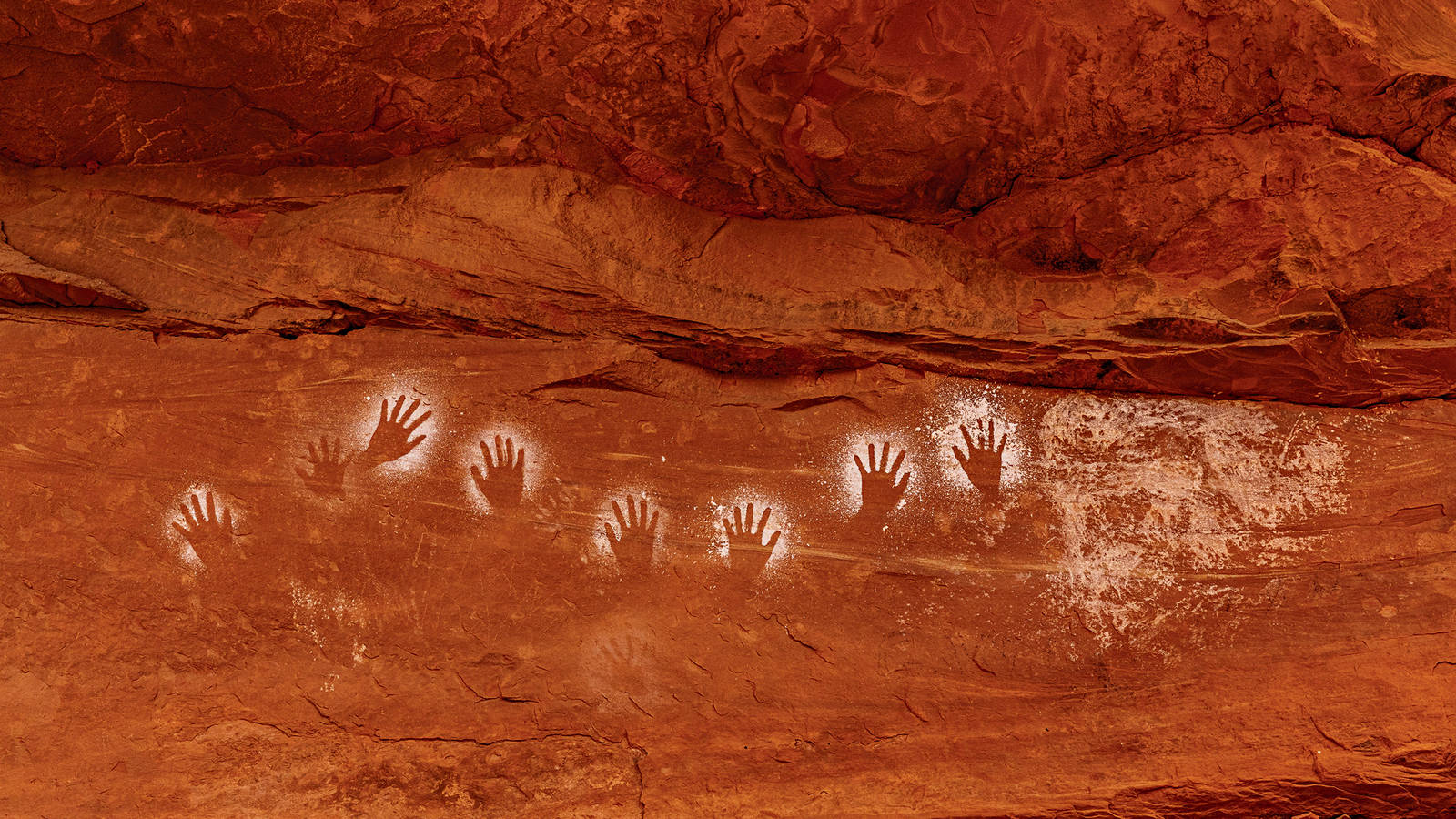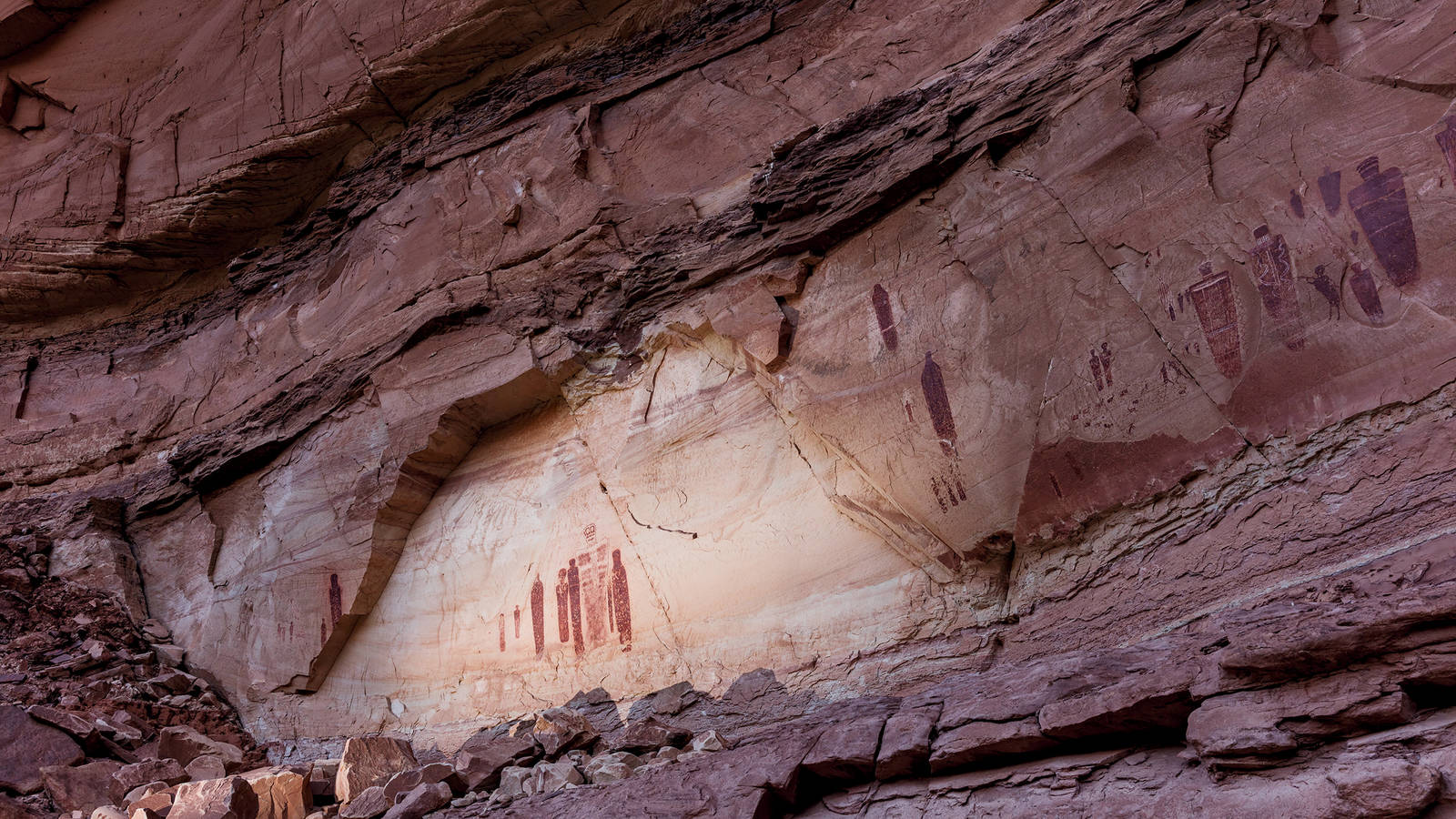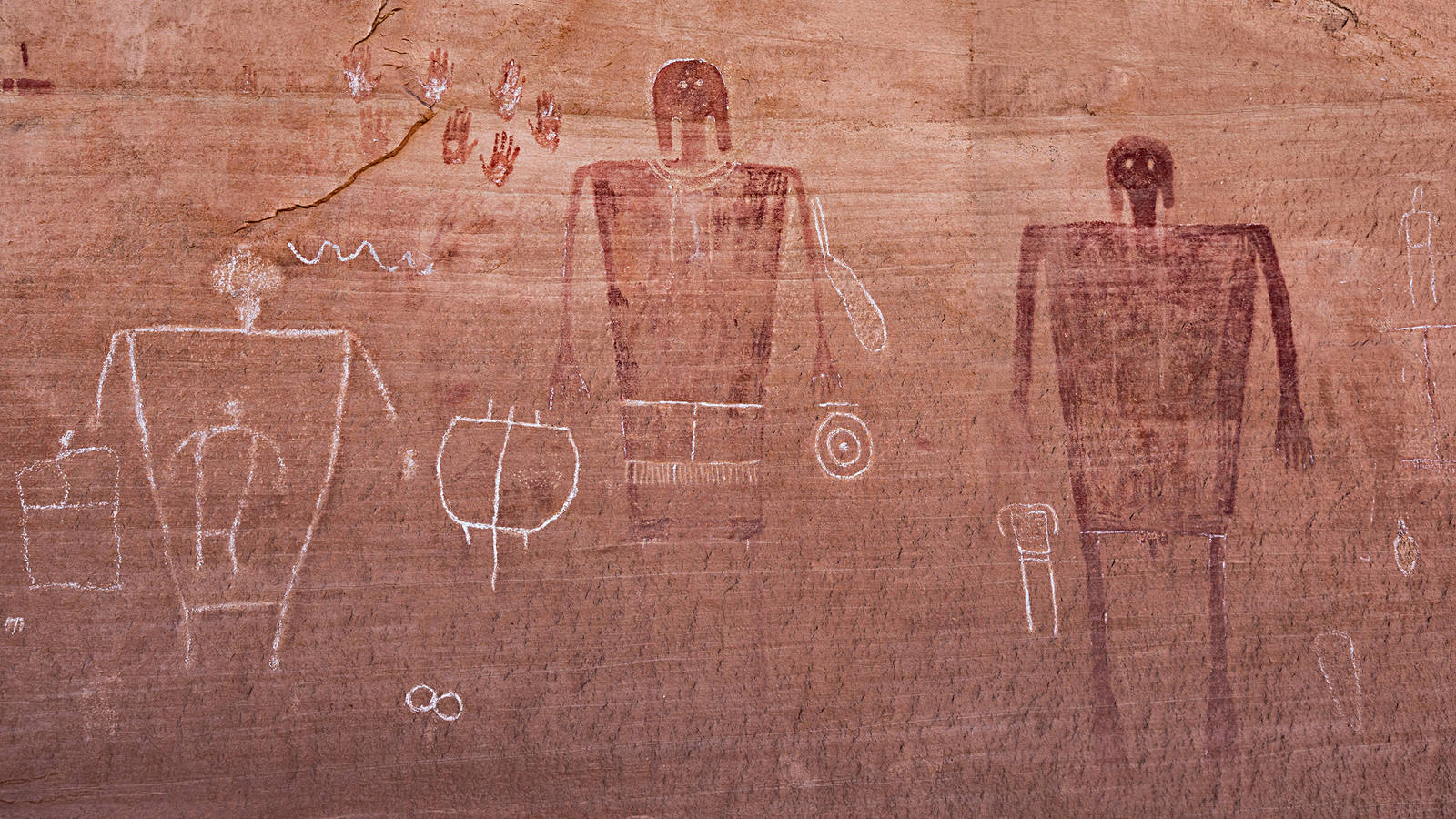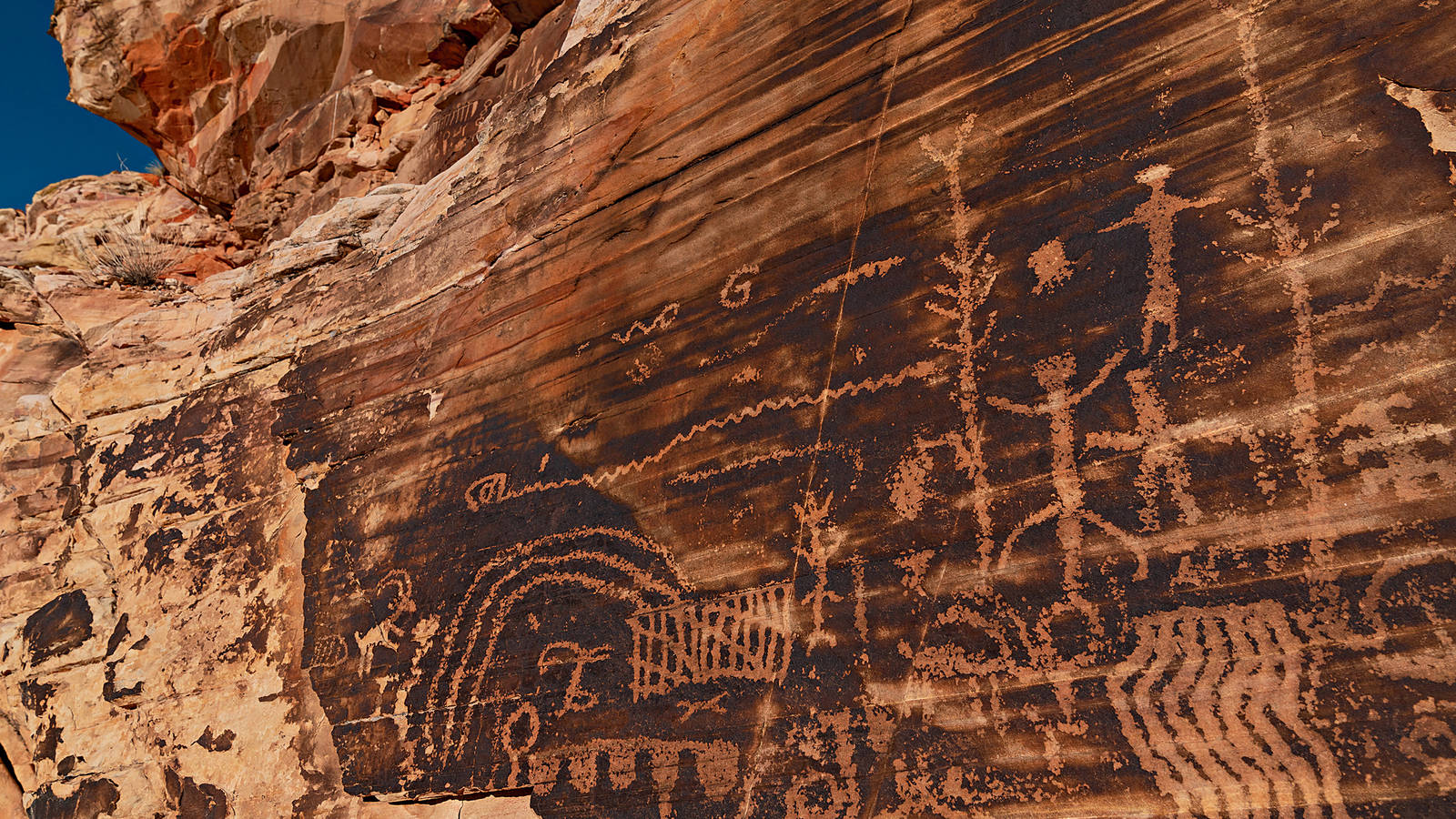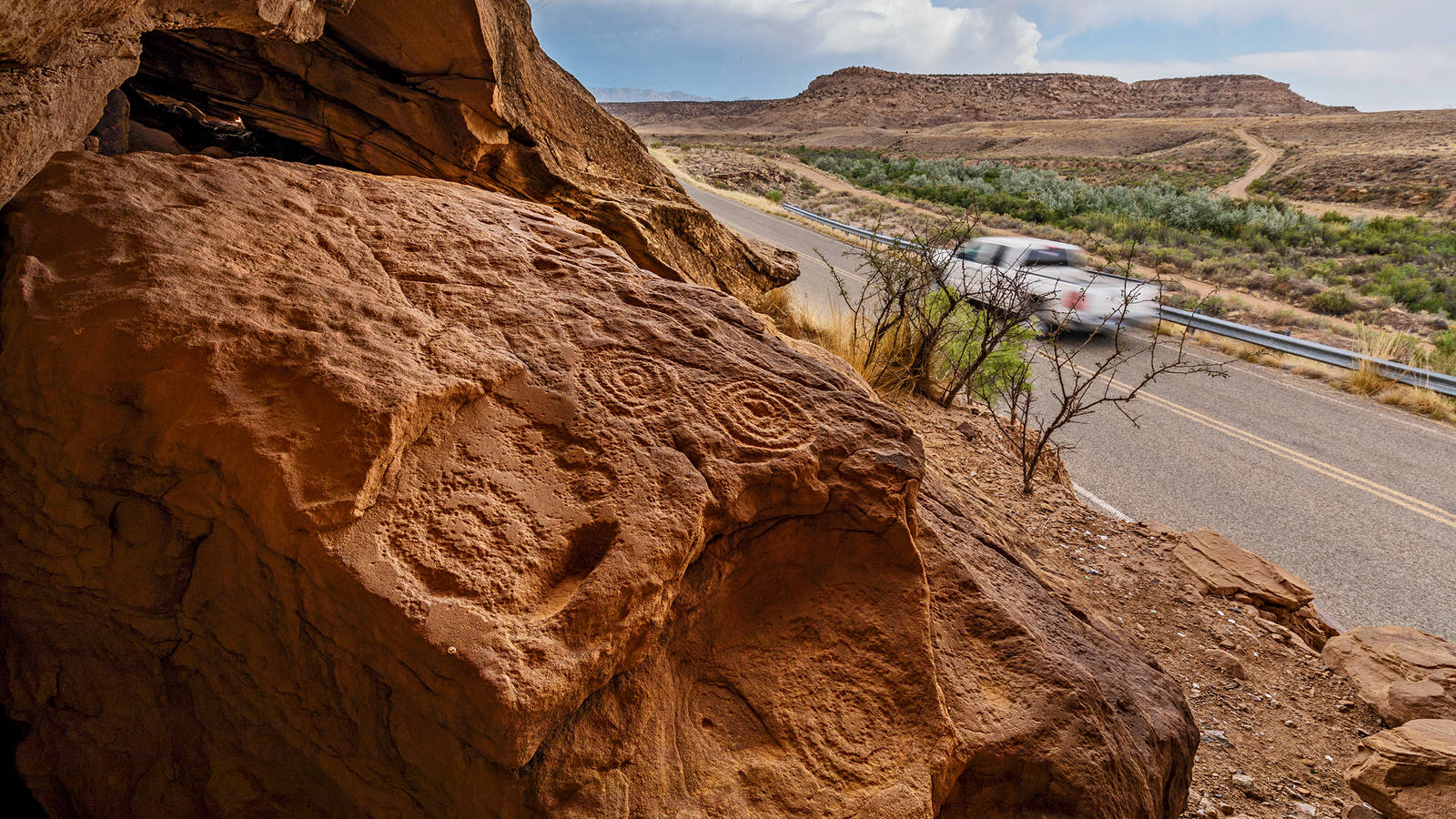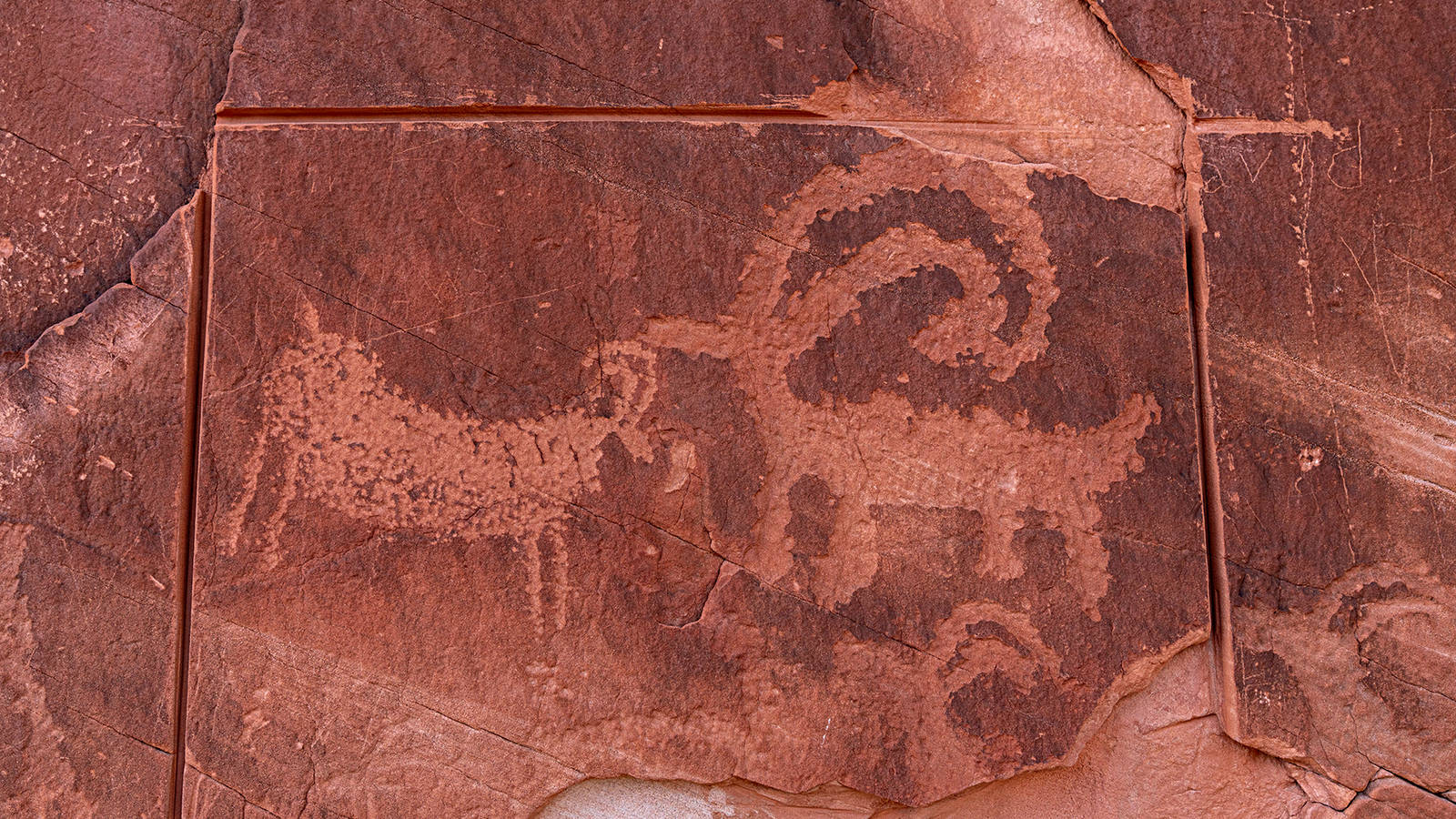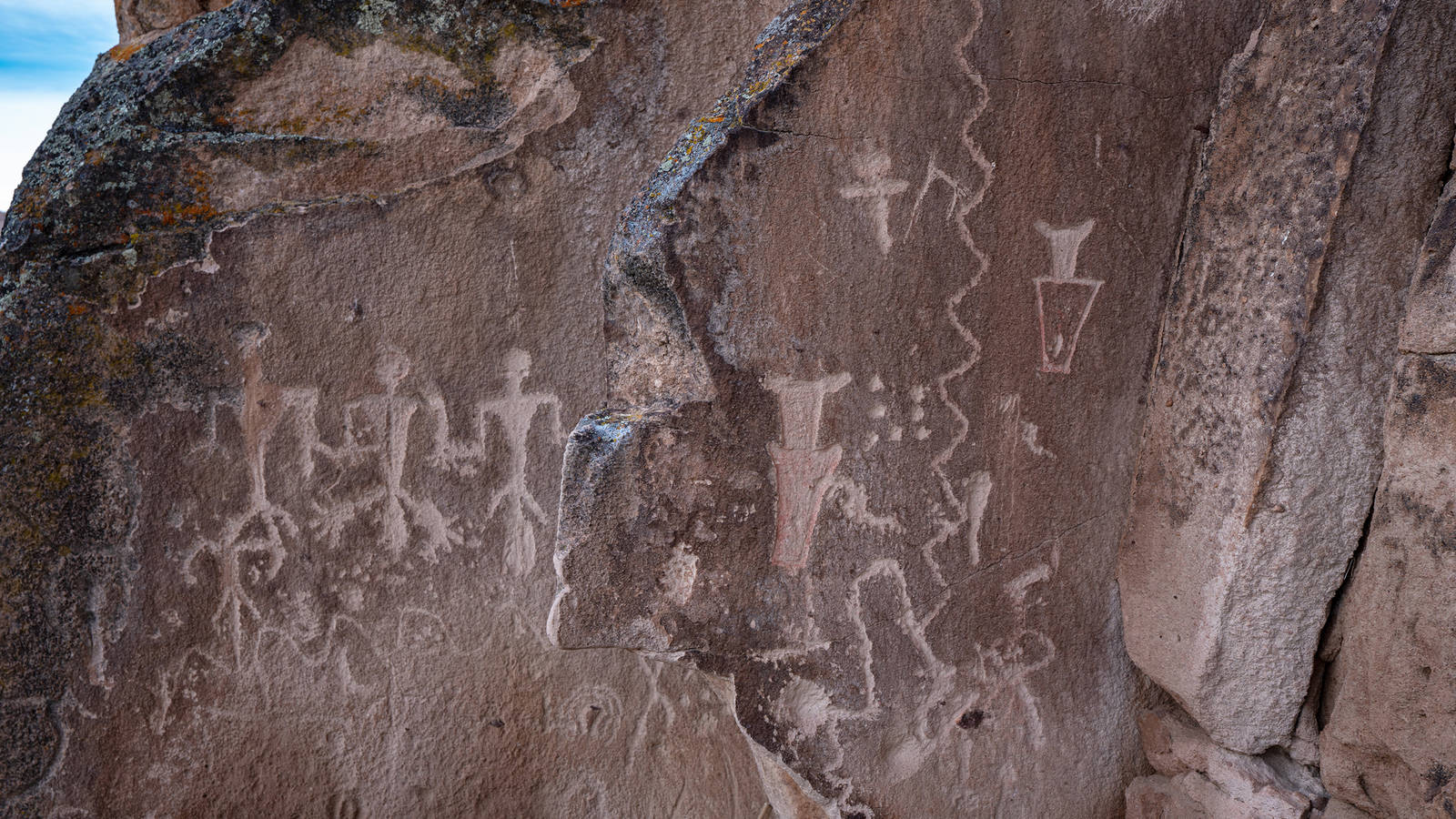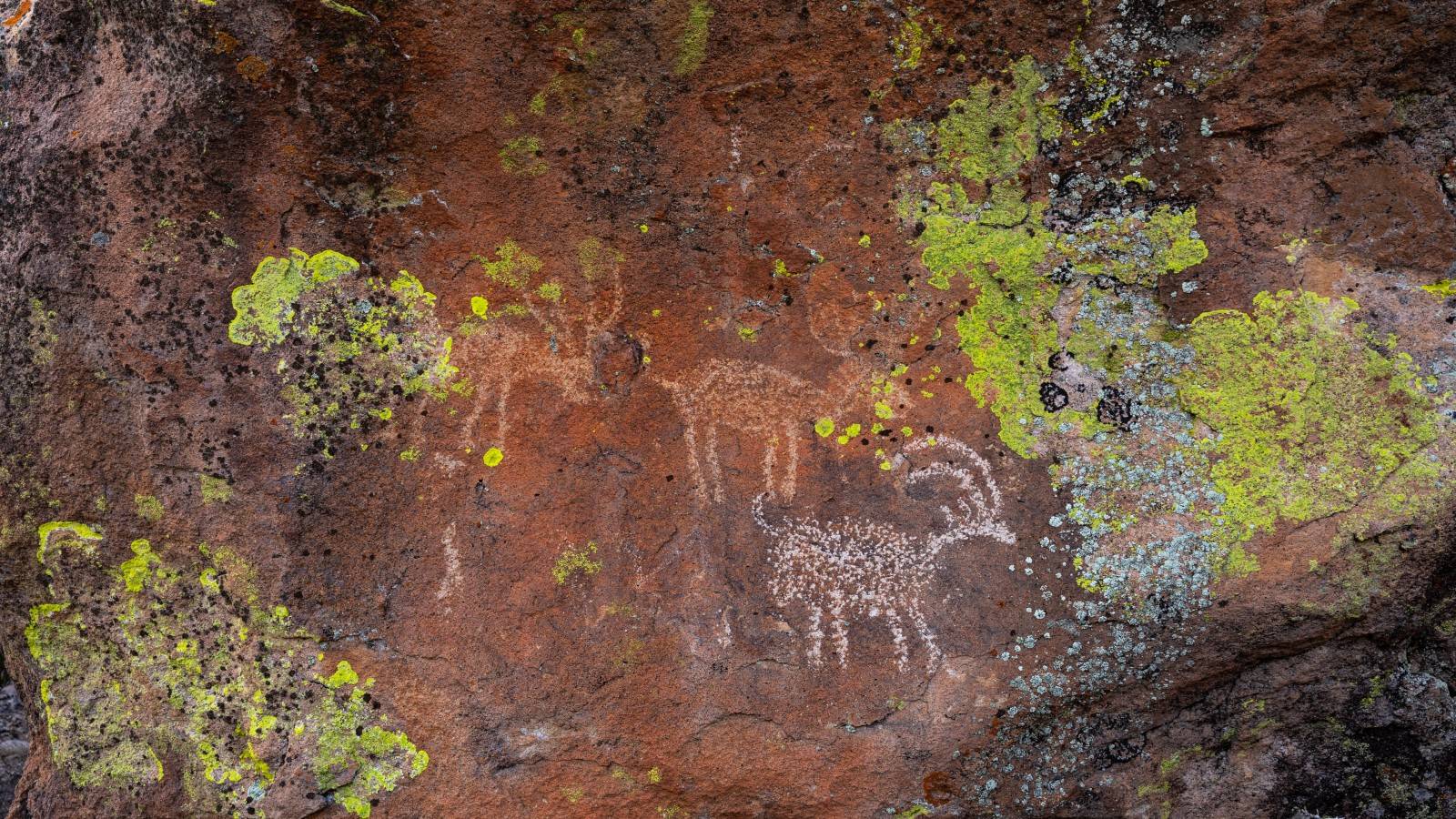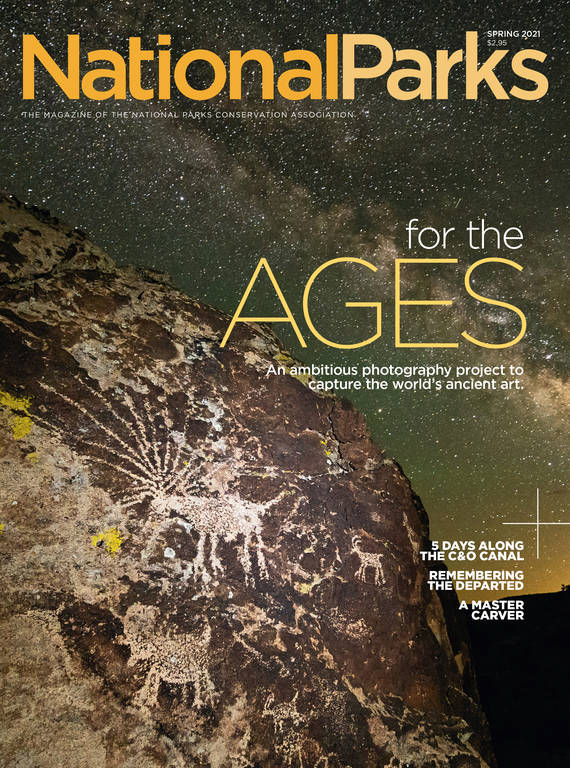Spring 2021
The Writing on the Wall
Stephen Alvarez travels the globe to photograph ancient rock art. His collection from the American Southwest includes images of Canyonlands, Bears Ears and Grand Staircase-Escalante.
In the spring of 2010, National Geographic photographer Stephen Alvarez had just finished a grueling three-month assignment documenting Paris’ underground places. Exhausted, he was looking forward to a relaxing beach vacation with his family. But on the way to the coast, his wife insisted on a detour to visit the replica of Lascaux, a cave full of prehistoric paintings in the southwest of France.
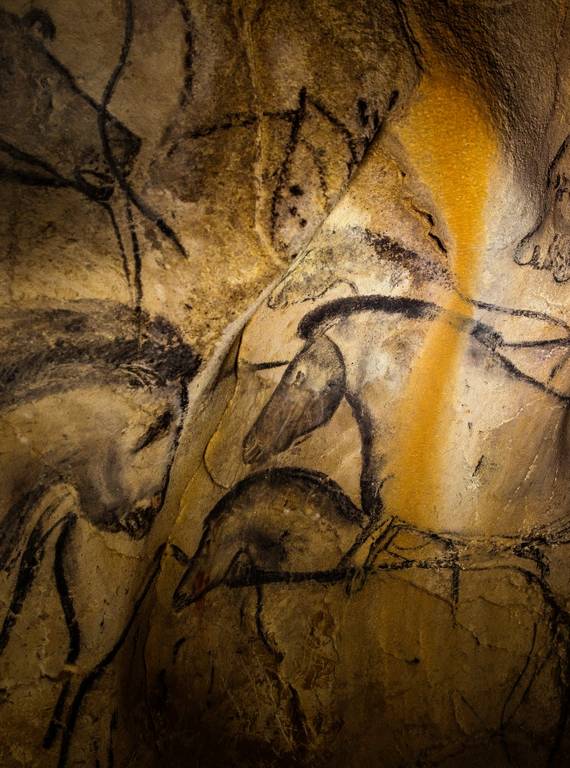
Paintings in the cave of Chauvet-Pont-d'Arc in France.
© STEPHEN ALVAREZ“I was like a petulant child,” recalled Alvarez, now 56, with a laugh. After months of working beneath the surface of Paris, exploring centuries-old quarries and catacombs, “I was like, I don’t want to go underground and see a bad reproduction of bad caveman art.” Nonetheless, on the appointed day, he dutifully shuffled into the dim chamber with his wife, two children and a small group of visitors. The lights clicked on, and reproductions of the magnificent 17,000-year-old paintings and engravings came into view.
“Everyone in the room, maybe 20 of us in the tour, gasps, because the artwork — and this is just the reproduction of the artwork — is so sophisticated,” he said. “I thought ancient people were intellectually primitive, and clearly they’re not.”
It was a lightbulb moment. Alvarez, who is also a filmmaker and explorer, began to wonder if prehistoric art was a tantalizing clue to understanding the development of the modern human mind. Over the years, his curiosity spurred him to travel to 15 countries in search of the most intriguing works, culminating in a National Geographic magazine feature on the origins of art in 2015. During the project, Alvarez realized both the difficulty of accessing what he calls rock art sites and the profound impact they can have on viewers. So he dreamed up a novel idea: a digital archive of sites from around the globe that would let regular people gaze at seldom seen works for as long as they like and connect to the minds of our distant forebears. In 2016, the nonprofit Ancient Art Archive was born. A trove of photographs, videos and 3D models (essentially virtual tours that can be viewed on any computer), the archive aims to compile the most beautiful and significant prehistoric rock art, stories and markings from six continents.
While the archive includes the work of four other photographers, it is mostly stocked with Alvarez’s own work, including photos from his National Geographic assignments, such as those documenting the Cave of Chauvet-Pont d’Arc, a famed French repository of 36,000-year-old paintings of rhinoceroses, mammoths, lions and bison.
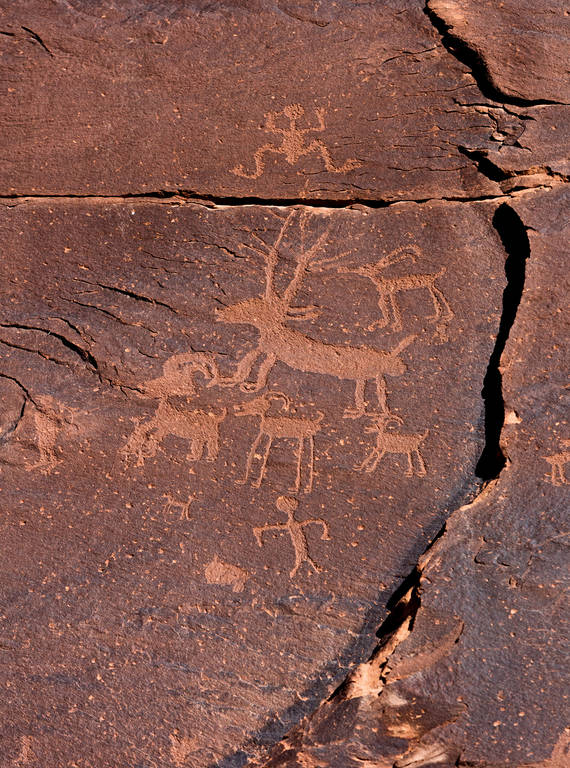
Thousands of petroglyphs dot the Sand Island Campground near Bears Ears National Monument. In some cases, visitors don’t even need to get out of their cars to see them.
© STEPHEN ALVAREZ“Standing in front of a drawing that old is just a revelation of an experience,” said Alvarez. “What happens is it’s like this artist talks to you, straight to you, from this unimaginable gulf of time. … I wanted as many people as possible to have that experience.”
The works captured in the archive range from a 77,000-year-old engraved red ochre block from South Africa, which is one of the oldest-known pieces of artwork in the world, to 800-year-old petroglyphs in the American Southwest. Many of the significant prehistoric rock stories and markings in the U.S. that are included in the archive are located on public lands such as Grand Staircase-Escalante National Monument, which harbors stick-like figures painted onto cliffs, and Canyonlands National Park, which features eerie 6-foot-tall pictographs of humanoid figures that could be thousands of years old.
Alvarez founded the archive in part to help protect these ancient and delicate sites. Threats include overwhelming levels of visitation, which lead to degradation and, in some cases, vandalism. (One way that foot traffic can damage pictographs in desert canyons is through abrasion caused by dust in the air.) Climate change also poses a significant hazard because it can shift the conditions that preserved the fragile artwork. In Mesa Verde National Park in Colorado, for instance, staff believe that freeze-thaw cycles are contributing to the erosion of stony amphitheaters that shelter ancient dwellings and petroglyphs. Petroglyphs have also been damaged by wildfires, which are raging more frequently as a result of climate trends. Political threats loom, too. In 2018, Alvarez undertook a project with the help of a grant from the National Geographic Society to document the artwork in seven national monuments that the Trump administration was considering for reduction, including Bears Ears and Grand Staircase-Escalante in Utah.
The goal of that project was to draw attention to the fact that one of the main reasons these parks were established was to protect the irreplaceable and spiritually significant cultural treasures within them, such as Bears Ears’ Procession Panel, a depiction of some 180 humanoid figures descending on what is believed to be a kiva, a sacred ceremonial gathering place. The area’s artwork is important to associated tribes, who collaborated in unprecedented ways to help establish Bears Ears.
In 2017, Bears Ears and Grand Staircase-Escalante national monuments were reduced in size by 85% and almost 50%, respectively. Some cherished pictographs, or paintings, and petroglyphs, or etchings, now sit outside of the monuments’ boundaries, leaving them more vulnerable to damage from industrial activities such as mining. (Shortly after the Trump administration’s drastic reduction of Bears Ears, NPCA, eight other conservation organizations and several tribes sued the administration and charged that the decision was an abuse of power and a violation of the 1906 Antiquities Act. The Biden administration said in January that it would review the reductions of Bears Ears and Grand Staircase to determine whether to restore the national monuments’ original boundaries.)
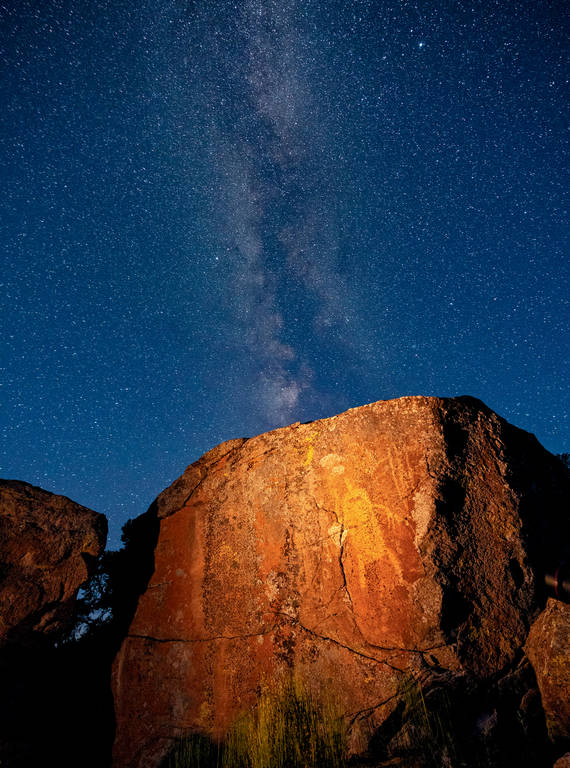
This style of petroglyphs in Basin and Range National Monument is found only in the Pahranagat Valley area of southeastern Nevada.
© STEPHEN ALVAREZIn the U.S., Alvarez sometimes spends years developing relationships with local Indigenous communities and secures permission from them to shoot the sites and share the images. He also works closely with tribes who wish to use his work for educational purposes. For example, in the region around Tennessee’s Devilstep Hollow Cave, which harbors ancient Native American petroglyphs and pictographs, Alvarez is partnering with school systems and libraries to host presentations for kids, many of whom are unaware this ancient artwork exists in their neighborhood. Alvarez and regional archaeologists have also presented 3D tours of a remote Alabama rock shelter, Chola Aayokachi’, which protects 800-year-old rock art, to Chickasaw tribal members who live in Oklahoma — hundreds of miles away from their ancestral homeland.
“The response was overwhelming for many Chickasaws,” said Brad R. Lieb, the director of archaeology for the Chickasaw Nation. “They were so interested to reconnect with these stories of their ancestors and to learn that the same characters can be found in sites as far as Kentucky and Wisconsin, all the way up and down the Mississippi River drainage.”
Typically, Alvarez needs to obtain permits from relevant government authorities before visiting a site. When on the ground, he regularly faces travel hassles and weather challenges. In the desert Southwest, it’s often too cold or too hot. In spring, the wind often kicks up dust storms, and in late summer, monsoons rush through most days, flooding once-passable roads. To access sites that are tucked deep into canyons, he often needs to drive long, rugged dirt roads and hike through sand and along steep rocky slopes.
Alvarez’s own creative process can also be labor-intensive. With an assistant, he sets up shots with complex arrangements of lamps and 20-foot booms that allow unique angles. He frequently waits for hours and sometimes days for the best light to arrive.
These painted outlines of human hands are in an area of Bears Ears that the Trump administration removed from the monument — illegally, according to NPCA. “I love handprints because they’re so personal,” Alvarez said. “I think of them as self-portraits … Even looking at them on the screen, I can’t resist
holding my hand up to see how my hand compares.” © STEPHEN ALVAREZ
Invasive burros pose one of the main threats to the pictographs and petroglyphs of the Great Gallery of Horseshoe Canyon in Canyonlands National Park, Utah. The animals strip the vegetation from nearby areas, loosening sand that, lifted in the air by seasonal winds, contributes to the erosion of the art.
© STEPHEN ALVAREZ
The Big Man Panel, located in Bears Ears, features reddish pictographs of human figures.
Visitors traced faint petroglyphs with chalk.
© STEPHEN ALVAREZ
Gold Butte, one of the country’s newest national monuments, was established in 2016 partly because of its exceptional rock art. The Falling Man area features human figures and bighorn sheep,
which are common motifs in Southwest rock art. © STEPHEN ALVAREZ
On the edge of Canyons of the Ancients National Monument in southwestern Colorado, an engraved boulder sits very close to the road, leaving it vulnerable to vandalism and plunder. © STEPHEN ALVAREZ
In Grand Staircase-Escalante National Monument in Utah, a would-be thief attempted to saw off a chunk of stone etched with petroglyphs. “Looting happens all the time,” Alvarez said. “These saw marks sum up
why I do what I do.” © STEPHEN ALVAREZ
Petroglyphs in Basin and Range National Monument, Nevada. © STEPHEN ALVAREZ
Bighorn sheep figures at Basin and Range National Monument. © STEPHEN ALVAREZ
As a younger photographer, Alvarez worked to develop a unique personal style, but he increasingly endeavors to get out of the way and let the ancient creator of the rock story or rock art speak through the image without any interpretation or editorialization. In the U.S., many of the sites he photographs are sacred places that continue to play important roles in the vibrant, living spiritual traditions of Indigenous communities, who interpret and relate to the works in myriad ways. “I think the important thing is to always be respectful,” he said. “The Southwestern saying is ‘Visit with respect,’ and it doesn’t just mean ‘Don’t walk on potsherds and arrowheads.’ It means ‘Take it seriously. Approach ancient artwork with humility.’”

National Parks
You can read this and other stories about history, nature, culture, art, conservation, travel, science and more in National Parks magazine. Your tax-deductible membership donation of $25 or more entitles…
See more ›Alvarez’s new project, which launched last year, is the Mural of America, a collection of photos, videos and 3D models documenting a dozen prehistoric art sites across North America that speak to what it means to be an American and are open to public visitation. The roster of sites has yet to be finalized but may include areas like the Great Gallery of Horseshoe Canyon, a parade of evocative figures located on a cliff in a remote area of Canyonlands National Park.
While the Great Gallery is accessible to anyone willing to drive a long dusty dirt road and hike 7 miles round trip, many other sites that Alvarez has photographed are not open to the public at all — or are so sensitive that land managers or tribes ask him not to publicize their locations. So one of Alvarez’s favorite things to do is to put a 3D headset on friends and show them these rarefied places. Unlike visitors, they can get as close to the artwork as they like. Most people are fascinated by it and want to know what it means. But that’s one thing that the Ancient Art Archive shies away from. “The artist certainly had a meaning and a story in mind, and it was probably a story that was well known to the community where they were from,” said Alvarez. “But the enigma is one of the reasons I love it so much.”
About the author
-
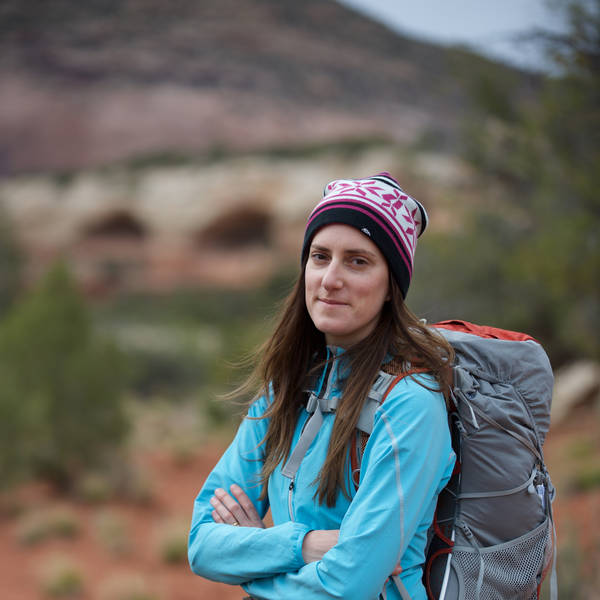 Kate Siber Contributor
Kate Siber ContributorKate Siber, a freelance writer and correspondent for Outside magazine, is based in Durango, Colorado. Her writing has appeared in National Geographic Traveler and The New York Times. She is also the author of “National Parks of the U.S.A.,” a best-selling children’s book.
